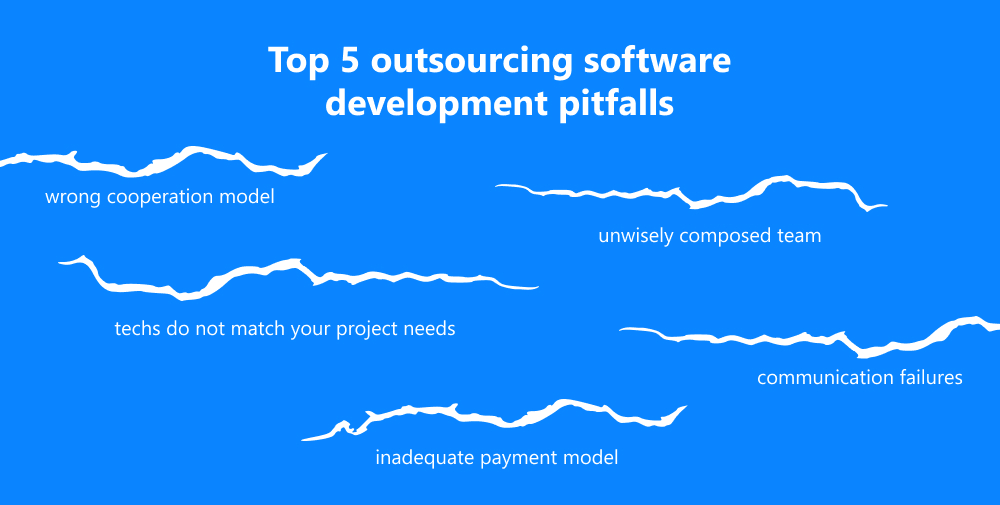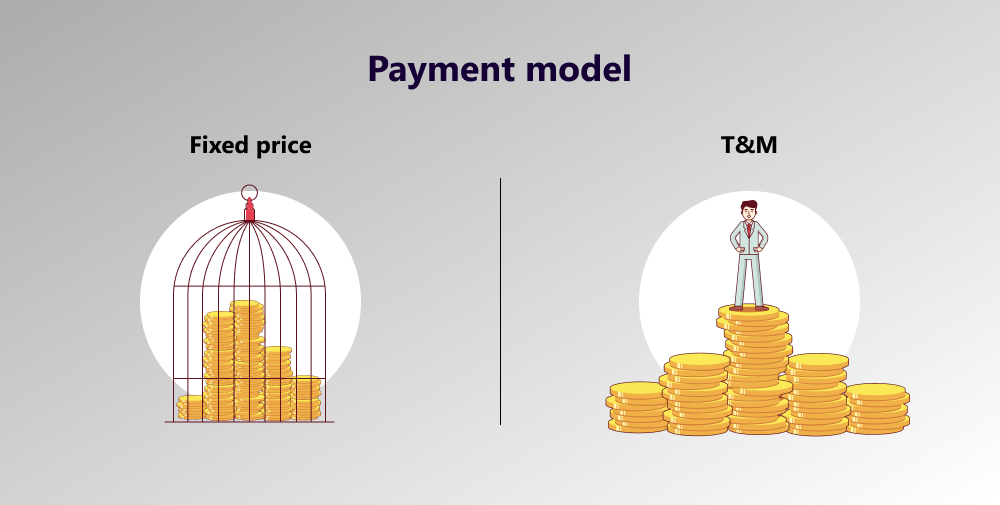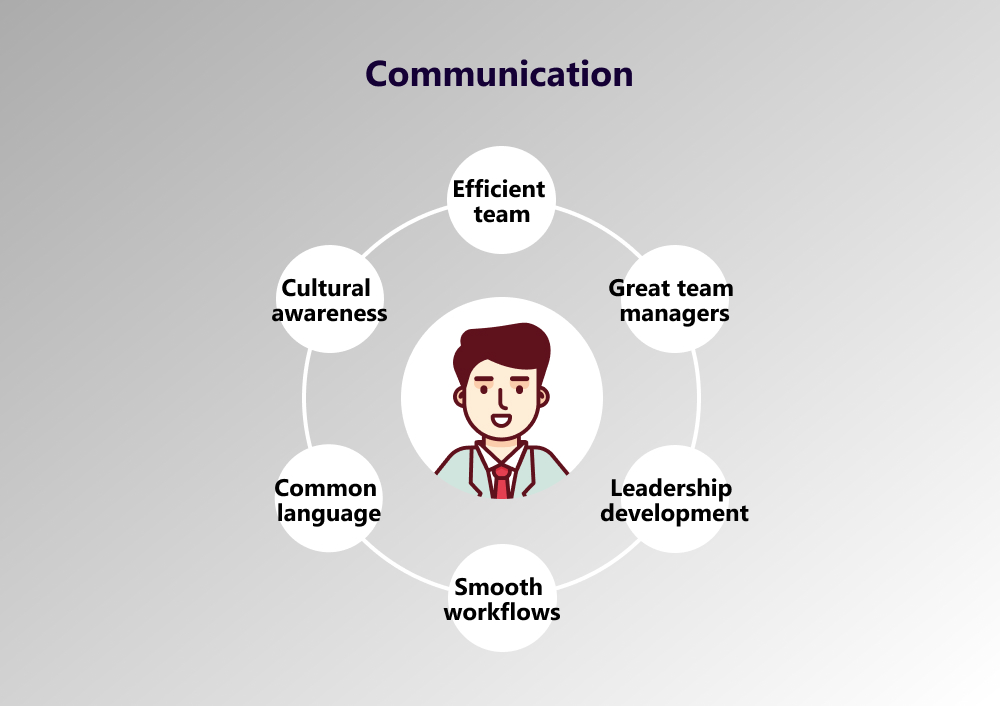Outsourcing is no fun when troubles arise all the time. Although it has multiple benefits which make employers outsource 300,000 jobs every year, such way of delivering projects may have some implications for you. The pitfalls that should be carefully explored before outsourcing include wrong cooperation model, unwisely composed team, wrong techs and payment model. For those who struggle to manage and communicate easily with their remote teams, we’ve also prepared a bonus point No. 5 – communication issues.
written by:
Veronica Chizh
Outsourcing is no fun when troubles arise all the time. Although it has multiple benefits which make employers outsource 300,000 jobs every year, such way of delivering projects may have some implications for you. The pitfalls that should be carefully explored before outsourcing include wrong cooperation model, unwisely composed team, wrong techs and payment model. For those who struggle to manage and communicate easily with their remote teams, we’ve also prepared a bonus point No. 5 – communication issues.
How often did you start a project so full of enthusiasm, highly-motivated, but ended up stressful and dissatisfied with the outcomes? Today we are going to discuss what you could possibly do wrong during your outsourced project which resulted in a troublesome delivery. Here are top 5 outsourcing software development pitfalls. These little nasty things may hinder your project advancement, but no longer will do so, ‘cause we will tell you how to cope with them. Read on for details!
Study these possible problems below to successfully avoid them and enjoy outsourcing to the fullest!
Cooperation model
Everything starts and ends up with the team. However, in the case of outsourcing, there are specifics of team building that you should know before taking people onboard. So, what are they?
In outsourcing, you have at least three options – three cooperation models – that you can and should choose wisely from. A pitfall No. 1 to avoid – choosing a wrong cooperation model. Below we will share with you which cooperation model will suit you best in which case.
Team expansion
If your team has been playing together for quite a time and knows well how to cope with the project difficulties on themselves, you don’t need outsourcing bad. However, when things go hard, you may require some helping hand part-time, which is where team expansion will work out just fine. Under this cooperation model, you hire a talent or several separate talents which perform a set of tasks for you within the specified period of time for the specified contribution.
Dedicated team
This is an outsourcing option that matches your needs the best if you look for a tightly-knit team of talents (6-8) which can be in charge of some part of the project or the whole project. A huge plus here is that the dedicated teams show higher KPIs due to the value added effect, stronger bonds within the team and empathy. A nice team play for the great results!
Development center
If you dream of a large team of talents (35+) who will be engaged solely on your project, go for a dedicated development center. This is the costliest outsourcing option of all, however it gives perfect results for the clients which have no development center of their own or require huge capacities for their comprehensive project. Moreover, if our clients choose a DC, we also provide them a separate infrastructure, office location for the talents engaged on their project, office space branding and introduce extra security/access measures.
Team composition
What can go wrong with team composition during an outsourcing project? The major 3 team composition setbacks are as follows: we do not need a BA, we need an architect, we need a full-stack developer.
The truth is, of all the three the only outsourcing must-have is a BA, while an architect is a nice-to-have and a full-stack developer is mauvais ton for complex projects. See below why.
Why do you need a BA?
All too often clients forget about such important pre-development activities as stakeholders interviewing, collection of requirements, risks estimation, etc. Moreover, your vision of the system should also be interpreted into the language of logic and development steps, which some team member should do. In the best case, this will be a business/system analyst. Otherwise, a team lead/an architect or a simple developer will do the job, which will be an unwise resource allocation.
Why you don’t need an architect?
Sometimes clients hire as many experienced talents as possible on their outsourcing project. However, the more is not always the better. If you outsource the system with a clean code, simple architecture which does not require code refactoring or a thorough overhaul, there’s a 95% chance you don’t need an architect. Furthermore, to make you think twice have a look at cost of the architect services – it’s the highest in the team. An ideal solution will be to hire an architect part-time, so that such a valuable and costly talent joins the team as and when necessary.
Why you don’t need a full-stack software developer?
You may have heard a lot about the miracles that full-stack engineers do to the projects and to the project budgets. As a software development company with 20-year long history, we have given a try to many trends that were considered must-haves at some points in IT-history. Full-stack development is no exception. It works out fine for small-scale projects that do not require deep domain knowledge or sophisticated tooling. For complex systems both front-end and back-end developers are required.
Technology stack
It’s obvious that, before the outsourcing team starts coding, you should come to a list of techs that should be used on the project. And here’s the rub: the tech stack defines the future of your project, and so does the person deciding on the techs to be used.
So, this is your third pitfall to avoid – never take important tech decisions on your own. Consult your architects and team leads, and of course ask your contractor for advice. After all, no outsourcing project ends up in success without trust between the parties.
Moreover, never try to imitate the tech stack of your competitors – the outsourcing project objectives and the challenges of the rival company may differ substantially of those of yours.
Payment model
It is so natural for the businesses to look for some predefined price at the very start of the outsourcing project and try to save to the max. That’s why choosing the fixed price model may sound like a great plan.
Here’s why it is not (and why it still may work out fine).
Fixed price
This payment model fits for the small-scale projects where each step can be easily planned and its cost reliably estimated.
The fixed price model will also play out greatly for outsourcing a chunk of work the scope for which won’t change (maintenance, system administration, etc.).
T&M
T&M is the only reasonable option for medium/large-scale systems where all the steps and actions cannot be readily estimated in advance. Moreover, in large projects alterations are inevitable, this is a hard fact that you simply should accept. As a result, the final estimates cannot be made until the system goes live.
Bonus point – Communication
Distance and different time zones may not be a problem in outsourcing at all. At least, this is not a bit a problem for Qulix Systems, although for many companies communication issues may put project delivery at risk. As for us, throughout the decades in the software development sector, we have accumulated and developed our own efficient approaches to tackling communication issues between the distributed teams. Those are as follows:
- Build efficient dedicated teams.
- Hire only professional team managers and invest into ongoing professional development of your tech leads.
- Establish great workflows that will help you deliver seamlessly.
- Learn how to deal with cultural and language barriers.
See more of our best practices that help us overcome communication issues in this article.
Concluding lines
Sure, this article describes only 5 possible software development stumbling blocks. However, these are the ones you should consider firsthand when starting your cooperation with an outsourcing company.
Without any doubt, every case varies and sometimes setbacks are unavoidable, as there’s no code without bugs and no project without setbacks. Yet, you can do a lot to mitigate the risks. A strong team, relevant techs and transparent payment pattern will guarantee smooth start which will continue through the whole project.
Find more software development tips on our website or contact our Support team for more detailed info about our projects.

Contacts
Feel free to get in touch with us! Use this contact form for an ASAP response.
Call us at +44 151 528 8015
E-mail us at request@qulix.com











